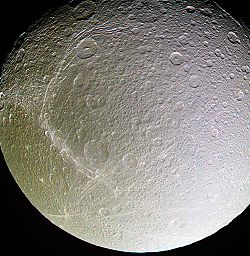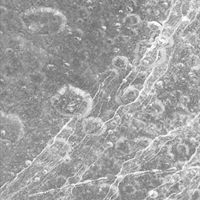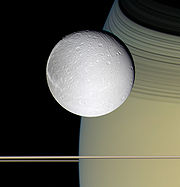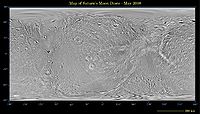.gif)
Dione (moon)
Encyclopedia
Dione is a moon
of Saturn
discovered by Cassini
in 1684. It is named after the titan
Dione
of Greek mythology
. It is also designated Saturn IV.
, Dione, Rhea
and Iapetus
) Sidera Lodoicea
("the stars of Louis") to honor king Louis XIV
. Cassini found Dione using a large aerial telescope
he set up on the grounds of the Paris Observatory
. The satellites of Saturn were not named until 1847, when William Herschel
's son, John Herschel
published Results of Astronomical Observations made at the Cape of Good Hope, and suggested the names of the Titans
, sisters and brothers of Cronos (the Greek Saturn), be used.
 At 1122 km in diameter, Dione is the 15th largest moon in the Solar System, and is more massive than all known moons smaller than itself combined. It is composed primarily of water ice, but as the third densest of Saturn's moons (after Enceladus
At 1122 km in diameter, Dione is the 15th largest moon in the Solar System, and is more massive than all known moons smaller than itself combined. It is composed primarily of water ice, but as the third densest of Saturn's moons (after Enceladus
and Titan
, whose density is increased by gravitational compression
) it must have a considerable fraction (~ 46%) of denser material like silicate
rock
in its interior.
Though somewhat smaller and denser, Dione is otherwise very similar to Rhea
. They both have similar albedo features and varied terrain, and both have dissimilar leading and trailing hemispheres. Dione's leading hemisphere is heavily cratered and is uniformly bright. Its trailing hemisphere, meanwhile, contains an unusual and distinctive surface feature: a network of bright ice cliffs.
Scientists recognise Dionean geological
features of the following types:

 When the Voyager
When the Voyager
space probe photographed Dione in 1980, it showed what appeared to be wispy features covering its trailing hemisphere. The origin of these features was mysterious, as all that was known was that the material has a high albedo
and is thin enough that it does not obscure the surface features underneath. One hypothesis was that shortly after its formation Dione was geologically active, and some process such as ice volcanism resurfaced much of its surface, with the streaks forming from eruptions along cracks in Dione's surface that fell back to the surface as snow or ash. Later, after the internal activity and resurfacing ceased, cratering continued primarily on the leading hemisphere and wiped out the streak patterns there.
This theory was proven wrong by the Cassini probe flyby of December 13, 2004, which produced close-up images. These revealed that the 'wisps' were in fact not ice deposits at all, but rather bright ice cliffs created by tectonic fractures (chasmata); Dione has been revealed as a world riven by enormous fractures on its trailing hemisphere.
The Cassini orbiter performed a closer flyby of Dione at 500 km (310.7 mi) on October 11, 2005, and captured oblique
images of the cliffs, showing that some of them are several hundred metres high.

satellite with the highest cratering rates on the leading hemisphere and the lowest on the trailing hemisphere. This suggests that during the period of heavy bombardment, Dione was tidally locked to Saturn in the opposite orientation. Because Dione is relatively small, an impact causing a 35 kilometer crater could have spun the satellite. Since there are many craters larger than 35 kilometres (21.7 mi), Dione could have been repeatedly spun during its early heavy bombardment. The pattern of cratering since then and the bright albedo of the leading side suggests that Dione has remained in its current orientation for several billion years.
Like Callisto
, Dione's craters lack the high relief features seen on the Moon
and Mercury
; this is probably due to slumping of the weak icy crust over geologic time.

Natural satellite
A natural satellite or moon is a celestial body that orbits a planet or smaller body, which is called its primary. The two terms are used synonymously for non-artificial satellites of planets, of dwarf planets, and of minor planets....
of Saturn
Saturn
Saturn is the sixth planet from the Sun and the second largest planet in the Solar System, after Jupiter. Saturn is named after the Roman god Saturn, equated to the Greek Cronus , the Babylonian Ninurta and the Hindu Shani. Saturn's astronomical symbol represents the Roman god's sickle.Saturn,...
discovered by Cassini
Giovanni Domenico Cassini
This article is about the Italian-born astronomer. For his French-born great-grandson, see Jean-Dominique Cassini.Giovanni Domenico Cassini was an Italian/French mathematician, astronomer, engineer, and astrologer...
in 1684. It is named after the titan
Titan (mythology)
In Greek mythology, the Titans were a race of powerful deities, descendants of Gaia and Uranus, that ruled during the legendary Golden Age....
Dione
Dione (mythology)
Dione was a Greek goddess primarily known as the mother of Aphrodite in Book V of Homer's Iliad. Aphrodite journeys to Dione's side after she has been wounded in battle protecting her favorite son Aeneas. In this episode, Dione seems to be the equivalent of the earth goddess Gaia, whom Homer also...
of Greek mythology
Greek mythology
Greek mythology is the body of myths and legends belonging to the ancient Greeks, concerning their gods and heroes, the nature of the world, and the origins and significance of their own cult and ritual practices. They were a part of religion in ancient Greece...
. It is also designated Saturn IV.
Name
Cassini named the four moons he discovered (TethysTethys (moon)
Tethys or Saturn III is a mid-sized moon of Saturn about across. It was discovered by G. D. Cassini in 1684 and is named after titan Tethys of Greek mythology. Tethys is pronounced |Odysseus]] is about 400 km in diameter, while the largest graben—Ithaca Chasma is about 100 km wide and...
, Dione, Rhea
Rhea (moon)
Rhea is the second-largest moon of Saturn and the ninth largest moon in the Solar System. It was discovered in 1672 by Giovanni Domenico Cassini.-Name:Rhea is named after the Titan Rhea of Greek mythology, "mother of the gods"...
and Iapetus
Iapetus (moon)
Iapetus ), occasionally Japetus , is the third-largest moon of Saturn, and eleventh in the Solar System. It was discovered by Giovanni Domenico Cassini in 1671...
) Sidera Lodoicea
Sidera Lodoicea
Sidera Lodoicea is the name given by the astronomer Giovanni Domenico Cassini to the four moons of Saturn discovered by him in the years 1671, 1672, and 1684 and published in his Découverte de deux nouvelles planètes autour de Saturne in 1673 and in the Journal des sçavans in 1686...
("the stars of Louis") to honor king Louis XIV
Louis XIV of France
Louis XIV , known as Louis the Great or the Sun King , was a Bourbon monarch who ruled as King of France and Navarre. His reign, from 1643 to his death in 1715, began at the age of four and lasted seventy-two years, three months, and eighteen days...
. Cassini found Dione using a large aerial telescope
Aerial telescope
An aerial telescope is a type of very-long-focal-length refracting telescope built in the second half of the 17th century that did not use a tube. Instead, the objective was mounted on a pole, tree, tower, building or other structure on a swivel ball-joint. The observer stood on the ground and held...
he set up on the grounds of the Paris Observatory
Paris Observatory
The Paris Observatory is the foremost astronomical observatory of France, and one of the largest astronomical centres in the world...
. The satellites of Saturn were not named until 1847, when William Herschel
William Herschel
Sir Frederick William Herschel, KH, FRS, German: Friedrich Wilhelm Herschel was a German-born British astronomer, technical expert, and composer. Born in Hanover, Wilhelm first followed his father into the Military Band of Hanover, but emigrated to Britain at age 19...
's son, John Herschel
John Herschel
Sir John Frederick William Herschel, 1st Baronet KH, FRS ,was an English mathematician, astronomer, chemist, and experimental photographer/inventor, who in some years also did valuable botanical work...
published Results of Astronomical Observations made at the Cape of Good Hope, and suggested the names of the Titans
Titan (mythology)
In Greek mythology, the Titans were a race of powerful deities, descendants of Gaia and Uranus, that ruled during the legendary Golden Age....
, sisters and brothers of Cronos (the Greek Saturn), be used.
Physical characteristics

Enceladus (moon)
Enceladus is the sixth-largest of the moons of Saturn. It was discovered in 1789 by William Herschel. Until the two Voyager spacecraft passed near it in the early 1980s very little was known about this small moon besides the identification of water ice on its surface...
and Titan
Titan (moon)
Titan , or Saturn VI, is the largest moon of Saturn, the only natural satellite known to have a dense atmosphere, and the only object other than Earth for which clear evidence of stable bodies of surface liquid has been found....
, whose density is increased by gravitational compression
Gravitational compression
Gravitational compression is a phenomenon in which gravity, acting on the mass of an object, compresses it, reducing its size and increasing the object's density....
) it must have a considerable fraction (~ 46%) of denser material like silicate
Silicate
A silicate is a compound containing a silicon bearing anion. The great majority of silicates are oxides, but hexafluorosilicate and other anions are also included. This article focuses mainly on the Si-O anions. Silicates comprise the majority of the earth's crust, as well as the other...
rock
Rock (geology)
In geology, rock or stone is a naturally occurring solid aggregate of minerals and/or mineraloids.The Earth's outer solid layer, the lithosphere, is made of rock. In general rocks are of three types, namely, igneous, sedimentary, and metamorphic...
in its interior.
Though somewhat smaller and denser, Dione is otherwise very similar to Rhea
Rhea (moon)
Rhea is the second-largest moon of Saturn and the ninth largest moon in the Solar System. It was discovered in 1672 by Giovanni Domenico Cassini.-Name:Rhea is named after the Titan Rhea of Greek mythology, "mother of the gods"...
. They both have similar albedo features and varied terrain, and both have dissimilar leading and trailing hemispheres. Dione's leading hemisphere is heavily cratered and is uniformly bright. Its trailing hemisphere, meanwhile, contains an unusual and distinctive surface feature: a network of bright ice cliffs.
Scientists recognise Dionean geological
Geology
Geology is the science comprising the study of solid Earth, the rocks of which it is composed, and the processes by which it evolves. Geology gives insight into the history of the Earth, as it provides the primary evidence for plate tectonics, the evolutionary history of life, and past climates...
features of the following types:
- ChasmaChasmaChasma is a term used in astrogeology to refer to "a deep, elongated, steep-sided depression". The plural is chasmata. An example is Eos Chasma on Mars. Below are images of some of the major chasmata of Mars...
ta (chasms; long, deep, steep-sided depressions) - DorsaWrinkle-ridgeA wrinkle ridge is a type of feature commonly found on lunar maria. These features are low, sinuous ridges formed on the mare surface that can extend for up to several hundred kilometers. Wrinkle ridges are tectonic features created when the basaltic lava first cooled and contracted...
(ridges) - FossaeFossa (geology)Fossa is a term used in planetary geology to describe a long, narrow depression on the surface of an extraterrestrial body, such as a planet or moon...
(long narrow depressions) - CratersImpact craterIn the broadest sense, the term impact crater can be applied to any depression, natural or manmade, resulting from the high velocity impact of a projectile with a larger body...
- CatenaeCrater chainA crater chain is a line of craters along the surface of an astronomical body. The descriptor term for crater chains is catena , as specified by the International Astronomical Union's rules on planetary nomenclature....
(crater chains)

The ice cliffs (formerly 'wispy terrain')

Voyager
-Technology:*LG Voyager, a mobile phone model manufactured by LG Electronics*NCR Voyager, a computer platform produced by NCR Corporation*Voyager , a computer worm affecting Oracle databases...
space probe photographed Dione in 1980, it showed what appeared to be wispy features covering its trailing hemisphere. The origin of these features was mysterious, as all that was known was that the material has a high albedo
Albedo
Albedo , or reflection coefficient, is the diffuse reflectivity or reflecting power of a surface. It is defined as the ratio of reflected radiation from the surface to incident radiation upon it...
and is thin enough that it does not obscure the surface features underneath. One hypothesis was that shortly after its formation Dione was geologically active, and some process such as ice volcanism resurfaced much of its surface, with the streaks forming from eruptions along cracks in Dione's surface that fell back to the surface as snow or ash. Later, after the internal activity and resurfacing ceased, cratering continued primarily on the leading hemisphere and wiped out the streak patterns there.
This theory was proven wrong by the Cassini probe flyby of December 13, 2004, which produced close-up images. These revealed that the 'wisps' were in fact not ice deposits at all, but rather bright ice cliffs created by tectonic fractures (chasmata); Dione has been revealed as a world riven by enormous fractures on its trailing hemisphere.
The Cassini orbiter performed a closer flyby of Dione at 500 km (310.7 mi) on October 11, 2005, and captured oblique
Angle
In geometry, an angle is the figure formed by two rays sharing a common endpoint, called the vertex of the angle.Angles are usually presumed to be in a Euclidean plane with the circle taken for standard with regard to direction. In fact, an angle is frequently viewed as a measure of an circular arc...
images of the cliffs, showing that some of them are several hundred metres high.

Craters
Dione's icy surface includes heavily cratered terrain, moderately cratered plains, lightly cratered plains, and areas of tectonic fractures. The heavily cratered terrain has numerous craters greater than 100 kilometres (62.1 mi) in diameter. The plains areas tends to have craters less than 30 kilometres (18.6 mi) in diameter. Some of the plains are more heavily cratered than others. Much of the heavily cratered terrain is located on the trailing hemisphere, with the less cratered plains areas present on the leading hemisphere. This is the opposite of what some scientists expected; Shoemaker and Wolfe proposed a cratering model for a tidally lockedTidal locking
Tidal locking occurs when the gravitational gradient makes one side of an astronomical body always face another; for example, the same side of the Earth's Moon always faces the Earth. A tidally locked body takes just as long to rotate around its own axis as it does to revolve around its partner...
satellite with the highest cratering rates on the leading hemisphere and the lowest on the trailing hemisphere. This suggests that during the period of heavy bombardment, Dione was tidally locked to Saturn in the opposite orientation. Because Dione is relatively small, an impact causing a 35 kilometer crater could have spun the satellite. Since there are many craters larger than 35 kilometres (21.7 mi), Dione could have been repeatedly spun during its early heavy bombardment. The pattern of cratering since then and the bright albedo of the leading side suggests that Dione has remained in its current orientation for several billion years.
Like Callisto
Callisto (moon)
Callisto named after the Greek mythological figure of Callisto) is a moon of the planet Jupiter. It was discovered in 1610 by Galileo Galilei. It is the third-largest moon in the Solar System and the second largest in the Jovian system, after Ganymede. Callisto has about 99% the diameter of the...
, Dione's craters lack the high relief features seen on the Moon
Moon
The Moon is Earth's only known natural satellite,There are a number of near-Earth asteroids including 3753 Cruithne that are co-orbital with Earth: their orbits bring them close to Earth for periods of time but then alter in the long term . These are quasi-satellites and not true moons. For more...
and Mercury
Mercury (planet)
Mercury is the innermost and smallest planet in the Solar System, orbiting the Sun once every 87.969 Earth days. The orbit of Mercury has the highest eccentricity of all the Solar System planets, and it has the smallest axial tilt. It completes three rotations about its axis for every two orbits...
; this is probably due to slumping of the weak icy crust over geologic time.

Exploration
Dione was first imaged by the Voyager space probes. It has also been imaged several times from closer distances by the Cassini orbiter. There was one close targeted fly-by, at a distance of 500 km on 2005 October 11; another similarly close fly-by was performed on 2010 April 7. A third fly-by is scheduled for 2011 December 12 at an altitude of 99 km..See also
- Dione in fiction
- The moon HeleneHelene (moon)Helene is a moon of Saturn. It was discovered by Pierre Laques and Jean Lecacheux in 1980 from ground-based observations at Pic du Midi Observatory, and was designated . In 1988 it was officially named after Helen of Troy, who was the granddaughter of Cronus in Greek mythology...
, which orbits in Dione's leading Lagrangian pointLagrangian pointThe Lagrangian points are the five positions in an orbital configuration where a small object affected only by gravity can theoretically be stationary relative to two larger objects...
, . - The moon PolydeucesPolydeuces (moon)Polydeuces is a very small natural satellite of Saturn that is co-orbital with Dione and librates around the trailing Lagrangian point . Its diameter is estimated to be about 3.5 km....
orbits in Dione's trailing Lagrangian point, .
External links
- Dione Profile at NASA's Solar System Exploration site
- The Planetary Society: Dione
- NASA probe video of approach to Dione
- Cassini images of Dione
- Images of Dione at JPL's Planetary Photojournal
- Dione global and polar basemaps (October 2010) from Cassini images
- Dione atlas (Sept. 2011) from Cassini images
- Dione nomenclature and Dione map with feature names from the USGS planetary nomenclature page

